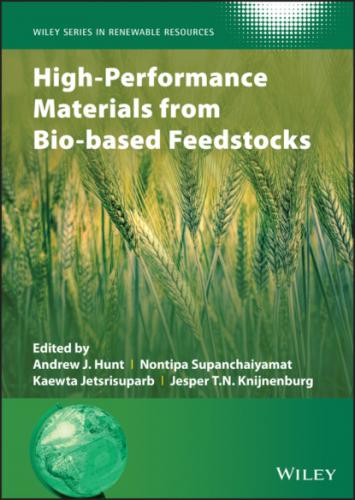3 Chapter 4Table 4.1 Conversion techniques and activation procedures for the preparatio...
4 Chapter 7Table 7.1 Adsorption performance of precious and rare earth metals of select...Table 7.2 Adsorption performance of precious and rare earth metals of select...Table 7.3 Adsorption performance of precious and rare earth metals of select...Table 7.4 Adsorption performance of precious metals of selected lignin‐based...
5 Chapter 8Table 8.1 Bio‐based materials used in the development of anti‐HIV drug deliv...
6 Chapter 9Table 9.1 Various bio‐feedstocks for obtaining biopolymers. Table 9.2 Summary of special characteristics of target ligand‐modified Cs‐ba...Table 9.3 Summary of special features/application in multifunctional modific...Table 9.4 Summary of special features/biomedical application in Cs‐based nan...
7 Chapter 12Table 12.1 Examples of bio‐based MOFs for which green or near‐green synthesi...Table 12.2 Comparison between MOFs and alternative materials.
8 Chapter 13Table 13.1 Typical chemical compositions of rice husk ash, palm oil fuel ash...Table 13.2 Typical chemical compositions of external‐source materials.
9 Chapter 15Table 15.1 Classification of bio‐based polymers. Table 15.2 Mechanical properties of PLA blends with bio‐based toughening age...
10 Chapter 16Table 16.1 Structures and sources of common biopolymers.
List of Illustrations
1 Chapter 2Figure 2.1 Some advantages of bio‐based carbon materials. Figure 2.2 Classification of biomass. Figure 2.3 Thermochemical processes for biomass conversion. Figure 2.4 Examples of chemical reactions catalyzed by biomass‐derived carbo...Figure 2.5 Transesterification of triglyceride. Figure 2.6 Esterification of fatty acid. Figure 2.7 Esterification of acetic acid. Figure 2.8 Reduction of nitrobenzene. Figure 2.9 Conversion of glucose to 5‐hydroxymethylfurfural. Figure 2.10 Hydrolysis of cellulose. Figure 2.11 Hydrogenation of levulinic acid.
2 Chapter 3Figure 3.1 Role of capillary forces in the collapse of soft porous materials...Figure 3.2 Evolution of porosity as a function of water : butanol compositio...Figure 3.3 Comparison of porosity of the three major Starbon types. Figure 3.4 Diesterification of succinic acid in aqueous ethanol as a functio...Figure 3.5 Esterification of oleic acid with sulphonated Starbon materials....Figure 3.6 Conversion of xylose to furfural and extraction of furfural. Figure 3.7 Functionalisation of steroids via Starbon acid‐catalysed Ritter r...Figure 3.8 Friedel Crafts reactions catalysed by a range of Starbon acids. (...Figure 3.9 Synthesis of an N‐heterocyclic carbine‐based catalyst on the Star...Figure 3.10 Preparation of a chiral bis‐oxalolidinone catalyst via surface b...Figure 3.11 Selective acylation of a diol by a supported Cu‐bis‐oxalodinone/...Figure 3.12 Comparison of pH‐dependent adsorption behaviour (via COD reducti...Figure 3.13 Four bioactive molecules studied for adsorption/desorption behav...
3 Chapter 4Figure 4.1 Schematic illustration of the carbon cycle and the production of ...Figure 4.2 (a) Illustrated procedure of fabricating N, S co‐doped porous car...Figure 4.3 (a) Schematic of the synthesis process for the hemp‐derived carbo...Figure 4.4 (a) Schematic illustration of the preparation process of N, P‐co‐...Figure 4.5 (a) Schematic illustration of the synthetic process of the Co3O4/...Figure 4.6 (a) Illustration of fabrication of co‐doped egg‐CMS. SEM images o...
4 Chapter 5Figure 5.1 Schematic diagram showing the different products obtained from se...Figure 5.2 Schematic presentation of the charged and discharged structure of...Figure 5.3 (a) Schematic illustration of the fabrication procedure for hollo...Figure 5.4 Schematic diagram of a supercapacitor. Figure 5.5 Bio‐based binder structure and features. (a) CMC (sodium carboxym...Figure 5.6 Schematic representation of the polymer electrolyte membrane fuel...
5 Chapter 6Figure 6.1 Sample of starch plasticised with glycerol and choline chloride (...Figure 6.2 Dry leather samples aqueous post‐tanned in (a) and DES post‐tanne...Figure 6.3 Starch‐based thermoplastic wood after forming (a), after grinding...Figure 6.4 From the top going clockwise: starch composites made with orange ...
6 Chapter 7Figure 7.1 Natural abundance of precious metals and rare earth elements (REE...Figure 7.2 (a) SEM images of P‐CNC, P‐CNF, and T‐CNF before (top) and after ...Figure 7.3 (a) Synthetic route for the preparation of the CMC‐g‐PAA hydrogel...Figure 7.4 (a) Preparation of chitosan grafted on persimmon tannin extract (...Figure 7.5 Reaction pathway for the synthesis of amidoxime‐modified magnetic...Figure 7.6 Removal of Au, Pd, Pt, and Ag by SAPAs, SAPVA, and activated carb...Figure 7.7 (a) SEM image of the PNMA‐LS composite spheres, (b) TEM image of ...
7 Chapter 8Figure 8.1 Representative images of various drug delivery systems in develop...
8 Chapter 9Figure 9.1 Schematic representation of the cell‐wall fractionation and sea a...Figure 9.2 CSMMA NPs for efficient gene transfection and drug delivery.
9 Chapter 10Figure 10.1 Carbohydrate–protein interactions between pathogenic agents and ...Figure 10.2 Exemplified multivalent glycomaterials using different scaffolds...Figure 10.3 Chemical structures and applications of cellulose, chitosan, amy...Figure 10.4 Chemical structures of the physiological ligand silyl Lewisx and...Figure 10.5 The natural ligand Man9 for DC‐SIGN and selected mono‐ and multi...Figure 10.6 Selected synthetic glyco‐gold nanoparticles and glycol‐quantum d...
10 Chapter 11Figure 11.1 Tissue engineering triad showing the factors influenced in tissu...Figure 11.2 Protein‐ or polysaccharide‐based scaffold architecture mimics th...
11 Chapter 12Figure 12.1 Suggested application of the principles of green chemistry to th...Figure 12.2 (a) Synthesis of the Zr(IV) MOF UiO‐66‐NH2 by twin‐screw extrusi...Figure 12.3 Examples of MOFs with bio‐based aliphatic
